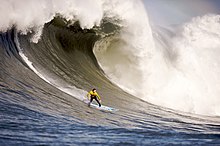
Back Branderplankry Afrikaans Surf AN Ȳþrīdung ANG ركمجة Arabic Surf AST Sörfinq Azerbaijani Сёрфинг Bashkir Selancar BAN Сёрфінг Byelorussian Сэрфінг BE-X-OLD
 Mavericks Surf Contest 2010 | |
| Highest governing body | World Surf League (WSL), International Surfing Association (ISA) |
|---|---|
| Characteristics | |
| Mixed-sex | Yes, separate competitions |
| Equipment | Surfboard, leash, wetsuit |
| Presence | |
| Country or region | Worldwide |
| Olympic | Since 2020 |
Surfing is a surface water sport in which an individual, a surfer (or two in tandem surfing), uses a board to ride on the forward section, or face, of a moving wave of water, which usually carries the surfer towards the shore. Waves suitable for surfing are primarily found on ocean shores, but can also be found in standing waves in the open ocean, in lakes, in rivers in the form of a tidal bore, or in wave pools.
The term surfing refers to a person riding a wave using a board, regardless of the stance. There are several types of boards. The Moche of Peru would often surf on reed craft, while the native peoples of the Pacific surfed waves on alaia, paipo, and other such water craft. Ancient cultures often surfed on their belly and knees, while the modern-day definition of surfing most often refers to a surfer riding a wave standing on a surfboard; this is also referred to as stand-up surfing.
Another prominent form of surfing is body boarding, where a surfer rides the wave on a bodyboard, either lying on their belly, drop knee (one foot and one knee on the board), or sometimes even standing up on a body board. Other types of surfing include knee boarding, surf matting (riding inflatable mats) and using foils. Body surfing, in which the wave is caught and ridden using the surfer's own body rather than a board, is very common and is considered by some surfers to be the purest form of surfing. The closest form of body surfing using a board is a handboard which normally has one strap over it to fit on one hand. Surfers who body board, body surf, or handboard feel more drag as they move through the water than stand up surfers do. This holds body surfers into a more turbulent part of the wave (often completely submerged by whitewater). In contrast, surfers who instead ride a hydrofoil feel substantially less drag and may ride unbroken waves in the open ocean.
Three major subdivisions within stand-up surfing are stand-up paddling, long boarding and short boarding with several major differences including the board design and length, the riding style and the kind of wave that is ridden.
In tow-in surfing (most often, but not exclusively, associated with big wave surfing), a motorized water vehicle such as a personal watercraft, tows the surfer into the wave front, helping the surfer match a large wave's speed, which is generally a higher speed than a self-propelled surfer can produce. Surfing-related sports such as paddle boarding and sea kayaking that are self-propelled by hand paddles do not require waves, and other derivative sports such as kite surfing and windsurfing rely primarily on wind for power, yet all of these platforms may also be used to ride waves. Recently with the use of V-drive boats,[clarification needed] Wakesurfing, in which one surfs on the wake of a boat, has emerged.[citation needed] As of 2023, the Guinness Book of World Records recognized a 26.2 m (86 ft) wave ride by Sebastian Steudtner at Nazaré, Portugal as the largest wave ever surfed.[1]
During the winter season in the northern hemisphere, the North Shore of Oahu, the third-largest island of Hawaii, is known for having some of the best waves in the world. Surfers from around the world flock to breaks like Backdoor, Waimea Bay, and Pipeline. However, there are still many popular surf spots around the world: Teahupo'o, located off the coast of Tahiti; Mavericks, California, United States; Cloudbreak, Tavarua Island, Fiji; Superbank, Gold Coast, Australia.[2]
In 2016 surfing was added by the International Olympic Committee (IOC) as an Olympic sport to begin at the 2020 Summer Olympics in Japan.[3] The first gold medalists of the Tokyo 2020 surfing men and women's competitions were, respectively, the Brazilian Ítalo Ferreira and the American from Hawaii, Carissa Moore.[4][5]

- ^ "Surfer rides World Record 26.21 m (86 ft) wave". Guinness World Records. 25 May 2022. Retrieved 22 March 2023.
- ^ Bremner, Jade (July 2013). "World's 50 best surf spots". CNN. Archived from the original on 9 August 2021. Retrieved 14 July 2021.
- ^ "IOC approves five new sports for Olympic Games Tokyo 2020". International Olympic Committee. 3 August 2016. Archived from the original on 6 August 2021. Retrieved 27 July 2021.
- ^ "Tóquio 2020: Ìtalo Ferreira consegue a inédita medalha de ouro em Tóquio 2020!!" [Tokyo 2020: Ìtalo Ferreira gets the unprecedented gold medal in Tokyo 2020!!]. Jornal O Maringá. 27 July 2021. Retrieved 21 July 2021.
- ^ "Carissa Moore, Italo Ferreira Win Surfing Gold". NYTimes. 27 July 2021. Retrieved 27 July 2021.
© MMXXIII Rich X Search. We shall prevail. All rights reserved. Rich X Search